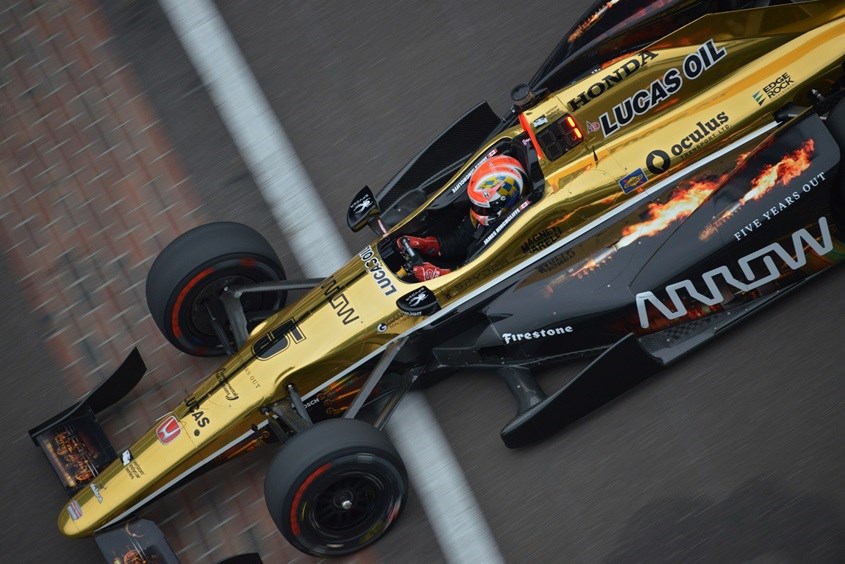376 days ago, James Hinchcliffe hit the wall at the Indianapolis Motor Speedway.
It was the largest recorded impact in IndyCar history; part of the suspension broke away and pierced his upper leg, puncturing the femoral artery. He very nearly bled to death.
But this Sunday, the self-deprecating native of Oakville, Ont., climbs into his race car at the head of the pack, having earned pole position by setting a blistering lap time during qualification. Last year, the Indy 500 nearly killed him. This year, he’s back for revenge.
It’s the kind of story you can’t help finding at Indy: danger, athleticism, determination, fearlessness. And, because this is a Canadian story, there’s plenty of beer involved too. Hinchcliffe has two of his own beers, Hammerdown Pilsner and The Bricks IPA, both brewed in collaboration with Flat12 Bierwerks in Indiana.
Well, I’m sold. Gentleman, start your sofas. Even if you’ve never watched a single motorsports event in your life, this Sunday’s 100th running of the Indy 500 is the event you don’t want to miss.
It’s a race steeped in tradition, and this year celebrates a century of some of the best circuit racing the world has ever seen. Actually, it’s more than a century: the first 500-mile race ran in 1911, and we’re only getting around to the 100th running because of inconvenient little things like multiple total world wars.
Those first racers must have been absolute madmen. The cars ran on a circuit of bricks laid over the original tar and crushed gravel. 3.2 million bricks make a huge oval, with a single lap running 2.5 miles. It’s what gives the track its nickname – the Brickyard – and a metre-wide strip of those original bricks sit exposed at the finish line.
Circuit racing, to the casual observer, doesn’t look nearly as challenging as something like the twisting Formula One circuit of Monaco. Indy cars boast similar big aerodynamics to the pinnacle of motorsport, but they only turn left: how hard can that be?
Answer: hard. Really, really hard. Where a Formula One race can be down to how much money the teams have thrown at the car as well as driver skill, the Indy 500 is a sort of blend of high-speed chess and guts and skill. With such long straightaways, the cars go to 230 miles per hour side-by-side, each searching for any advantage in speed.
Just to run a clean, fast lap requires a great deal of bravery, that first banked corner coming at you like a wall. You balance the car against the Gs, making sure to keep it away from the upper and lower parts of the track, where bits of tire are starting to accumulate, creating a slippery surface just waiting to break your grip and send you into the wall.
Thread the tarmac needle, then get back on the power gingerly. Indy cars make up to 700 horsepower and weigh half as much as a Honda Civic. Coming out of the curve, they rocket forward to max velocity, their 2.2-litre twin-turbo V-6s howling. Now do the whole thing again with 32 other cars trying to clinch victory.
I attended the Indy 500 two years back, almost immediately after watching an F1 race. The comparison between the two was nearly night and day: you could barely see the tops of the F1 drivers’ heads for the crowds, and only the cream of Europe got a chance to get close to the cars. The rest of us were kept at bay by layer after layer of electronically controlled security.
Meanwhile, for the cost of a ticket that’d barely get you upper bowl seating at a Canucks game, the Indy 500 offered totally intimate access. When the cars are staged and sitting ready to run, the doors are opened and the crowds allowed to march out and see them as close as you like, smell the tarmac, and even kiss that famous yard-wide stripe of bricks.
And then, before the race, there are all the traditions to be observed. That famous phrase, “Gentlemen, start your engines.” The blessing of the race. The hilariously anatomically correct nude racer atop the Borg Warner trophy. Parties in the infield. The baking Indiana sun.
The Indy 500 is the pulse of America’s heartland, and it remains totally unpretentious after all these years. Win a race anywhere else, you spray champagne; win the Indy, and you’ll be slugging back a pint of milk.
With the circus pared back, you can see the real stories here, the stories of the racers and their teams. Hinchcliffe seeks to put a Canadian flag on the top of the podium for the first time in two decades. Young Stefan Wilson is racing for his brother Justin, who died in a racing-related crash last August. Pippa Mann, the lone woman racer, is racing to raise funds for breast cancer research.
Grizzled veterans, fresh-faced rookies, personal missions, and the echoes of history. You don’t need to know every detail of the present, nor every wrinkle of the past. You don’t need to be a gearhead, or a race fan. You don’t even need to like cars.
The Indy 500 waits to weave its tale for the 100th time this Sunday. I’ll be watching. So should you.
Brendan McAleer is a freelance writer and automotive enthusiast. If you have a suggestion for a column, or would be interested in having your car club featured, please contact him at [email protected]. Follow Brendan on Twitter: @brendan_mcaleer.



